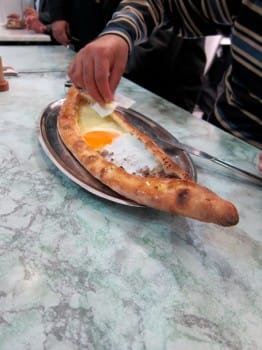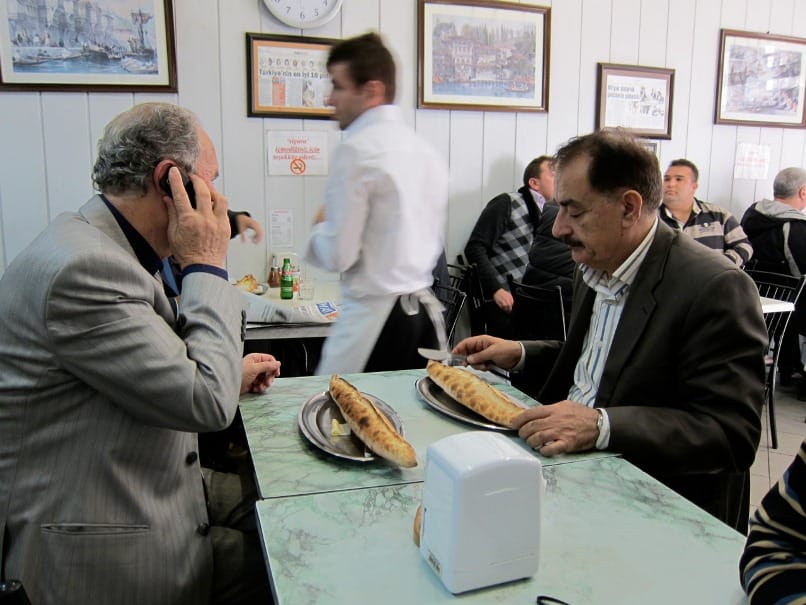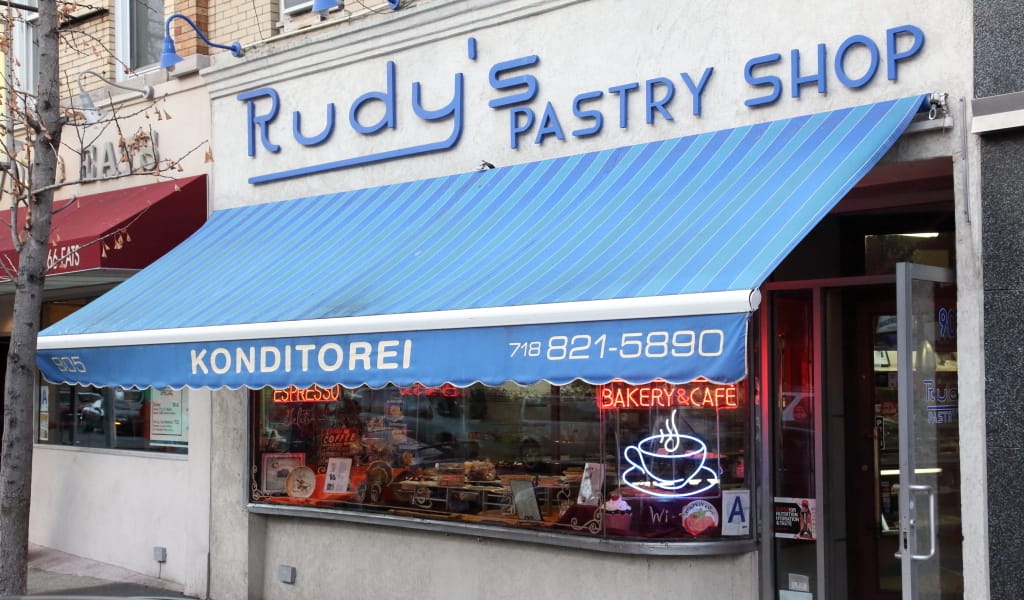Editor’s note: We regret to report that Fatih Karadeniz Pidecisi has closed.
Inside Fatih Karadeniz Pidecisi, nothing could be heard over the crunch and crackle of fresh pide being torn open and chomped down on. Still, the man across the table from us spoke in a low, conspiratorial whisper: “There are some very well-known businessmen sitting at that table by the window. They all come here,” he said.
It seemed to us that everyone in the crowded little dining room was well-known, at least among themselves. They greeted one another with a handshake, backslap and an “afiyet olsun.” While waiting for their pide to arrive, they barked commands into their cellphones and related workday anecdotes to the rest of the table. This place felt like the antechamber of many a local businessman’s office, with a twist: superb Karadeniz pidesi, or Black Sea-style pide.
We’d never encountered such noisy bread in Turkey until we visited Fatih Karadeniz Pidecisi. Nor had we ever seen a pide quite so long or standing so proud at its ends. In pide heaven, clouds are billowy, doughy pleasure boats, and this placed smelled as if we were floating on one. Intoxicated by the atmosphere, we failed to flag down the harried waiter for quite some time. “As if they are sending the pide in from Rize!” a hungry fellow at our table exclaimed, earning some nods and chuckles from the other tables.
Even if the service is a bit slow, the ordering process is straightforward. There’s peynirli pide (with cheese), which is open-faced, and kıymalı pide, which has minced meat and onions and is customarily closed like a long, slender, ridge-backed calzone. Meanwhile, a karışık (“mixed”) pide has one side of cheese and the other with meat and is offered open.
All these varieties of pide can be ordered with a topping of raw egg, if desired. We usually tended to pass on this, until we watched a group of men at an adjacent table simultaneously seesawing their pide to distribute a freshly cracked egg across the entire face of the pide, leaving a bright yolk slick that  quickly set. When our karışık with egg finally arrived, we mimicked the seesaw motion to spread the yolk from bow to stern while the pide was still hot and the egg still runny. We took the pat of butter wrapped in wax paper and rubbed down the ridges of crust until the butter was no more. The waiter stood by patiently throughout the whole affair and then took our pide back to the counter for slicing.
quickly set. When our karışık with egg finally arrived, we mimicked the seesaw motion to spread the yolk from bow to stern while the pide was still hot and the egg still runny. We took the pat of butter wrapped in wax paper and rubbed down the ridges of crust until the butter was no more. The waiter stood by patiently throughout the whole affair and then took our pide back to the counter for slicing.
Every part of this half-and-half pide performed at its highest level. The meat side sang the high notes of a fine lahmacun, while the cheese side offered a deep, rich backbeat. The egg slick – particularly the application of it – was a novel part of the ritual but, in our opinion, an unnecessary one. The skills of a pideci (pide-maker) are proven in the crust, not in the toppings. And this crust had the craters and ridges of a lunar landscape while remaining perfectly formed and sturdy in the face of a butter bath and thorough egging. It was chewy on the inside and startlingly light and crispy on the outside. It’s that crust and its hallmark crunch that has kept this place packed for more than 50 years. But don’t take our word for it; ask any well-known businessman in Fatih where he eats pide. Or just roll down the window, listen carefully and follow the crunch.
 October 11, 2021 Rudy’s Bakery and Café
October 11, 2021 Rudy’s Bakery and Café
If we could wind the clock back to 1934, to listen in as Rudy’s Bakery rolled its first […] Posted in Queens May 4, 2016 Casa Cavé
May 4, 2016 Casa Cavé
The popular saying that Rio is known more for its bar culture than for its café culture […] Posted in Rio June 23, 2020 Fine(d) Dining
June 23, 2020 Fine(d) Dining
The officials from the Ministry of Health came late in the evening on a Friday night and […] Posted in Tbilisi
Published on September 17, 2012
Related stories
October 11, 2021
QueensIf we could wind the clock back to 1934, to listen in as Rudy’s Bakery rolled its first strudel, German is the language we would have heard at the baker’s bench, and beside the glass-fronted display cases, and, more likely than not, on the sidewalk outside, along Seneca Ave. At least since the late 1800s,…
May 4, 2016
RioThe popular saying that Rio is known more for its bar culture than for its café culture has serious counter-evidence in the old city. Beginning in 1808, when Portuguese emperor Dom João fled Napoleon and relocated his imperial court to Rio, European architects, businessmen and intellectuals followed him and attempted to show that their society…
June 23, 2020
TbilisiThe officials from the Ministry of Health came late in the evening on a Friday night and entered Tbilisi’s popular gastro-entertainment complexes Fabrika and Ghvinis Karkhana-Wine Factory #1. They knew there would be a lot of people here celebrating life again after two and a half months in lockdown. They also understood that even with…


















































































